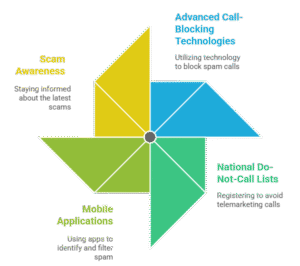On-Demand Outsourcing BPO Services for Healthcare Providers With 24/7 Coverage!
Save up to 70% on staffing costs!
Browse Specialty Staffing ServicesCall Data Helps Us Ignore Spam and Detect Trends in Healthcare

Every clinic experiences it: an influx of spam calls, potentially filling up lines that could be used for patient inquiries or appointment scheduling. These calls are more than just a nuisance. They are a significant drain on time, resources, and focus.
“Spam calls are like wasting time on calls that don’t bring value.”
For providers, spam calls clog communication lines, making it harder to engage with real patients. For staff, it’s about wasting time answering calls that don’t lead to anything productive. And for patients, it may delay essential care as lines are blocked by unsolicited calls.
How Big is the Spam Call Problem?
The average clinic could receive hundreds of calls daily, many of which are spam. These calls aren’t just an inconvenience—they can have a tangible impact.
Clinics can receive as many as 30-40 spam calls a day.
Time wasted handling these calls can add up to several hours per week.
The potential delay in patient communication and care can lead to missed opportunities and frustrated patients.
“We get more spam calls than actual patients calling in—it’s draining our resources.”
“When we’re flooded with spam calls, important patient inquiries get missed or delayed.”
Why Do Spam Calls Keep Coming?
Spam calls are an ongoing challenge because they come for several reasons:
Automated Call Systems: Many spam calls are driven by automated systems dialing large lists.
Scam Schemes: Fraudsters prey on healthcare-related data to trick people.
Robocalls: These calls attempt to sell products or services, wasting time for clinics.
Call Volume: Clinics are popular targets for spam because of the volume of calls they make.
“I get calls from every corner of the country offering insurance plans or fake medications.”
“The robocalls never stop, even when we’re on hold with patients!”
The Ripple Effect of Spam Calls
Spam calls impact more than just phone lines—they have a ripple effect throughout the clinic’s operations.
Staff Time Wasted: Time spent on spam calls could be better spent assisting real patients.
Patient Delays: Staff may miss or delay follow-up calls for patients because they are busy with irrelevant calls.
Communication Breakdown: Critical calls related to appointments, follow-ups, or emergencies can be delayed.
“We spent hours this week just trying to get through spam call blocks and missed real patient inquiries.”
“Some patients never get through because we were stuck dealing with spam calls.”
Why Traditional Solutions Fall Short
Many clinics use simple strategies like call screening, but these are often ineffective.
Call Blockers: These aren’t always accurate, often blocking legitimate calls as well.
Manual Call Screening: Staff doesn’t have the time to screen every call manually.
Spam Filters: Filters are often ineffective, allowing spam calls to slip through.
“We’ve blocked a hundred numbers, but the calls keep coming in from new ones.”
“It’s hard to manage all this while still providing quality care.”
Smarter Ways to Stop Spam Calls

Clinics can drastically reduce spam calls by using smarter, technology-driven solutions:
AI-Powered Call Screening
Automatically screens and blocks spam calls before they reach the clinic.
Flags suspicious numbers and prioritizes real patient calls.
“Once we implemented AI screening, spam calls dropped by 70%.”
Verified Caller Systems
Helps verify incoming calls from legitimate sources, making it easier for staff to identify real patients.
“Now we know when a call is important, and we can focus on patient needs.”
Virtual Receptionists with Spam Filters
Virtual assistants equipped with spam filters screen out unwanted calls and ensure smooth communication with patients.
“Outsourcing our phone line management really helped clear up the chaos from spam.”
Robocall Blockers
Block robocalls that are rampant in healthcare. Systems can automatically disconnect these calls.
“Our robocall blocker has cut down unnecessary calls by 80%.”
Two-Way Authentication for New Numbers
Ensures any unknown callers are verified through a second layer of authentication, reducing scam calls.
“When we started verifying numbers with a second layer, the calls dropped almost immediately.”
What Did We Learn?
Spam calls aren’t just a nuisance—they’re an operational headache that costs clinics valuable time and resources.
Key takeaways:
Spam calls waste clinic staff time and delay patient communication.
Traditional call screening methods are often ineffective.
Smarter, AI-driven call filtering and verification systems can drastically reduce spam calls.
By outsourcing or utilizing technology, clinics can focus on patient care rather than sifting through spam.
What People Are Asking?
Q: How much time do spam calls waste for a typical clinic?
A: Clinics can waste anywhere from 5–10 hours per week handling spam calls.
Q: Why don’t traditional call filters stop spam calls?
A: Spam callers constantly change numbers, and basic call filters don’t always block new ones effectively.
Q: Can outsourcing help reduce spam calls?
A: Yes. Virtual receptionists or call-handling services can be equipped with advanced spam filters, preventing unwanted calls from reaching the clinic.
Q: How does technology help with spam calls?
A: AI-driven systems can screen calls and use machine learning to block spam before it reaches staff, allowing them to focus on actual patients.
Q: What role does AI play in spam call prevention?
A: AI can continuously learn from patterns to block fraudulent or scam calls and even sort legitimate calls, ensuring clinics aren’t overwhelmed.
Disclaimer:
Spam calls aren’t just a minor inconvenience—they’re a significant problem that can be solved with technology. By combining AI, smart call screening, and outsourcing, clinics can reduce spam calls, free up staff time, and improve patient communication.
For tailored support and professional services, contact Staffingly, Inc.
📞 (800) 489-5877
📧 support@staffingly.com
 Book a Demo to Build Your Team Today!
Book a Demo to Build Your Team Today!

 Read Case Studies
Read Case Studies 


 Virtual Medical Assistants
Virtual Medical Assistants



